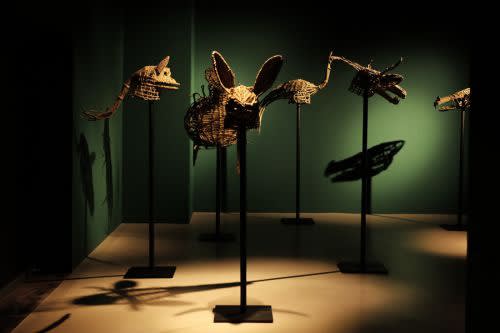Khvay Samnang Invokes Animist Spirits Against Environmental Exploitation
At Nova Contemporary, Bangkok, the artist draws on ancient ritual to intervene in current Cambodian politics
In the opening moments of the two-channel video installation Preah Kunlong (The Way of the Spirit, 2017), a semi-naked forest dweller wearing a crocodile mask of thick, knotted vines moves slowly atop a waterfall. On the other screen, meanwhile, a lithe half-human, half-cow figure gambols in a stream. Through lingering close-ups and wide-angle views of the fecund landscape, this duality of wistful masked performances continues: a peacock prowls through rice stalks while an elephant slowly flexes, and so forth.
Identities are often obscured or absent in Khvay Samnang’s research-centered work, which give vent to the frustrations and altercations of marginalized Cambodian communities via subtle interventions. The disenfranchised occupants of an iconic Phnom Penh housing block have been photographed wearing doll-like masks in their ramshackle apartments (Human Nature, 2010–11). Buckets of sand and raw rubber have been upended over Samnang’s head in solidarity with the victims of forced land reclamation and deforestation (Untitled, 2011, and Rubber Man, 2014).

In ‘A Forest of Spirits’ at Bangkok’s Nova Contemporary, Samnang introduces the predicament facing his hidden subjects through a succinct visual metaphor that embodies their close bond with a publicly contested environment. The 11 vine masks that populate this mesmeric work – first shown at documenta 14 – could easily pass for the worn totems of an ancient shamanic ritual, yet are, in fact, rooted in the politics of the present.
Back in 2014, Samnang set out to connect with the Chong, a Pearic-speaking minority group who have lived in southwest Cambodia’s Areng Valley, among their animist spirits and the beasts of the bio-diverse Cardamom Mountains, for over 600 years. Suspicious at first, the Chong slowly opened up to him at a time when they were mobilizing against a hydroelectric dam project proposed by Chinese state-owned company Sinohydro.
Created at workshops with Chong villagers, the animal masks are not common representational figures of the lok ta (ancestral guardian spirits) or neak ta (spirits of sacred places, animals or trees) that populate their collective cosmology. Rather, they are one-off, memory-based depictions of the animals from which their families’ intimate knowledge of the land, especially its water sources, has been inherited. Once the masks were completed, Samnang and a team set off into the forest where Rady Nget – a dancer trained in the indigenous classical dance form lakhoan koal – attempted to, as the exhibition’s curator Abhijan Toto writes, ‘exceed the human’.
Emerging at a moment when the dam – plans for which have since been shelved – seemed destined to go ahead and the Chong villagers were themselves engaging in sit-ins and other forms of direct action, Preah Kunlong can be read as a form of counter-mapping – an attempt to strengthen their claim to a land under threat of state-sanctioned exploitation. At Nova Contemporary, however, Nget’s fey, animalistic tics and courtship-like displays meet a new strategy of solidarity: mounted recastings of the masks in recycled bronze.

Whereas the vine masks, one of which is displayed in an upstairs gallery, are light enough to be worn, these copies made from melted-down sacred and mundane objects are much denser and heavier, though no less imperfect and intricate. To produce them, Samnang enlisted the help of Chong craftsmen who, while possessing a mastery of sculptural folk arts, nowadays mostly churn out Buddhist trinkets for tourists. Their cumulative effect is rousing. Through this process, the Chong’s indivisible bond with nature has been given a more rigid, monumental form – or, more precisely, face. And while the video articulates a community’s deep spiritual and physical entanglement with the land, this menagerie of heavy bronze masks represents, to my eyes at least, an inspiring hardening of resistance.


